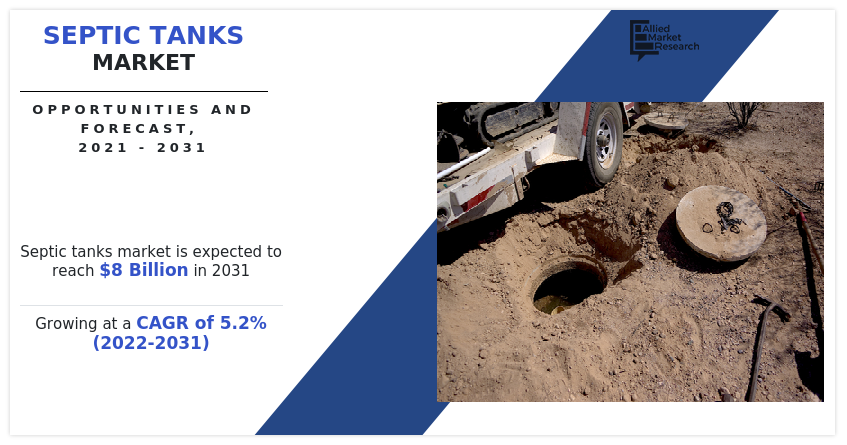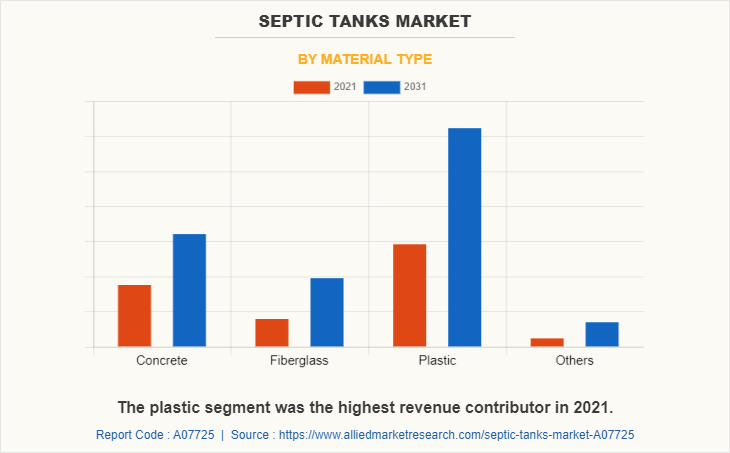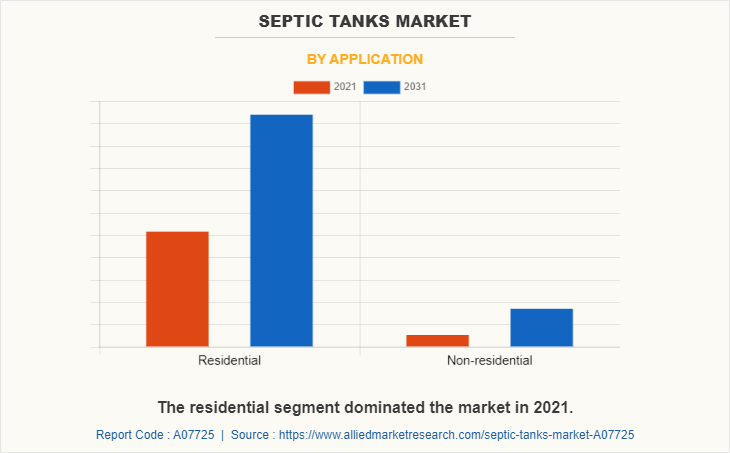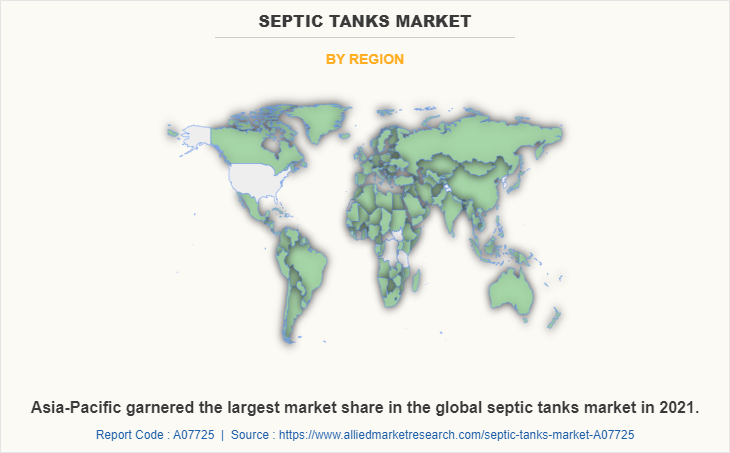Septic Tanks Market Research, 2031
The Global Septic Tanks Market Size was valued at $4.8 billion in 2021, and is projected to reach $8 billion by 2031, growing at a CAGR of 5.2% from 2022 to 2031.
Septic tanks are underground chambers made of fiberglass, plastic, or concrete in which domestic water and wastewater flows for basic sewage treatment. Septic tanks collect sewage and decompose it through bacterial activity. They are often used in residential and non-residential sectors in rural areas, campgrounds, and picnic areas in place of sewer systems to treat human waste and separate solids and liquids in wastewater.

Increase in commercial and residential construction has led to surge in demand for septic tanks. Moreover, rise in population and demand for better sanitation systems and wastewater treatment are expected to drive the septic tanks market during the forecast period. In addition, rise in awareness regarding benefits of using septic tanks for wastewater treatment to maintain health and hygiene fuels the septic tank market growth. Moreover, increase in government investments in infrastructure projects are providing lucrative growth in the market.
Increase in population in developing economies such as China, India, and the U.S. has led to rapid urbanization, which is expected to boost development of the residential sector and increase demand for septic tanks. According to the United Nations (UN), around 68% of the world population is expected to live in urban areas by 2050. This is expected to result in increase of residential construction activities around the globe and increase demand for septic tanks.

On the basis of material type, the plastic segment has registered highest revenue in 2021. Plastic septic tanks are resistant to corrosion caused by water and are waterproof. They are also rust-resistant. Plastic tanks are less prone to cracking since plastic is flexible, and thus a plastic septic tank does not crack as much as a cement septic tank. Plastic septic tanks are more hygienic than septic tanks made of cement.

On the basis of application, the residential segment has generated highest revenue in 2021. This is attributed to rising government investments in residential construction buildings. Similarly, growth in population in emerging nations such as the U.S., China and India are expected to increase residential construction, which propels demand for septic tanks. This is expected to boost growth of the septic tanks market forecast period.
The novel coronavirus (COVID-19) rapidly spread across various countries and regions in 2019, causing an enormous impact on the lives of people and the overall community. It began as a human health condition and has now become a significant threat to global trade, economy, and finance. The COVID-19 pandemic halted production of many products in the septic tanks market, owing to lockdowns. Furthermore, the number of COVID-19 cases is expected to reduce in the future with the introduction of the vaccine for COVID-19 on the market. This has led to the reopening of septic tanks companies at their full-scale capacities. This is expected to help the market recover by the end of 2022. After COVID-19 infection cases begin to decline, septic tank manufacturers must focus on protecting their staff, operations, and supply networks to respond to urgent emergencies and establish new methods of working.

Asia-Pacific dominated the market in 2021, accounting for the highest septic tanks market share, and is anticipated to maintain this trend throughout the forecast period. This is attributed to increase in population, urbanization, and industries in countries such as India, China and Japan. Thus, all such factors are expected to drive the septic tanks market growth in Asia-Pacific.
The septic tanks market is segmented into Material type, Capacity and Application. By material type, the market is categorized into concrete, plastic, fiberglass, and others. Depending on capacity, it is fragmented into under 1000 liters, 1000–5000mliters, and more than 5000 liters. On the basis of application, it is categorized into residential and non-residential. Region wise, the market is analyzed across North America, Europe, Asia-Pacific, and LAMEA.
Competition Analysis
Key companies profiled in the Septic tanks industry include Saint Dizier Environment, Asio, Biorock, Inc., Bluetec, Chem-Tainer Industries, Danmotech Ltd., Eurobeton, Graf UK Ltd., Indian Centrifuges, JoJo., Klargester Environmental, Orenco Systems, Inc., Rewatec, Simop, Techneau, WPL Ltd, and Zehnder Pumpen GmbH.
Key Benefits For Stakeholders
- This report provides a quantitative analysis of the market segments, current trends, estimations, and dynamics of the septic tanks market analysis from 2021 to 2031 to identify the prevailing septic tanks market opportunities.
- The market research is offered along with information related to key drivers, restraints, and opportunities.
- Porter's five forces analysis highlights the potency of buyers and suppliers to enable stakeholders make profit-oriented business decisions and strengthen their supplier-buyer network.
- In-depth analysis of the septic tanks market segmentation assists to determine the prevailing market opportunities.
- Major countries in each region are mapped according to their revenue contribution to the global market.
- Market player positioning facilitates benchmarking and provides a clear understanding of the present position of the market players.
- The report includes the analysis of the regional as well as global septic tanks market trends, key players, market segments, application areas, and market growth strategies.
Septic Tanks Market Report Highlights
| Aspects | Details |
| By Material type |
|
| By Capacity |
|
| By Application |
|
| By Region |
|
| Key Market Players | Orenco Systems, Inc., Saint Dizier Environnement, Biorock, Inc., Bluetec, Klargester Environmental, Chem-Tainer Industries, Eurobeton, Zehnder Pumpen GmbH, Asio, Techneau, Graf UK Ltd., Danmotech Ltd., Rewatec, Conder Sewage technology Ltd, Simop, JoJo., WPL Ltd |
Analyst Review
The septic tanks market has witnessed significant growth in past few years, owing to increase in urban population, industrialization, and stringent government norms for providing better sanitation and wastewater treatment facilities. Moreover, increasing government and private sector investments in residential and commercial construction fuel the market growth. Rise in population in developed countries such as China, the U.S., and India are increasing demand for residential construction and drive the septic tanks market growth. Moreover, rise in awareness regarding better sanitation system and maintain cleanliness are driving the septic tanks market growth.
Moreover, governments of various countries are focusing on formulating better sanitation laws and regulations, which is expected to increase demand for septic tanks. For instance, in June 2020, the Florida Department of Environmental Protection has formed new law for maintaining human health and environment by installation of septic tanks. The legislation also directs the state DEP to update regulations that apply to storm water systems. As a result, such factors provide lucrative growth in the septic tanks market.
The global septic tanks market capacity was valued at $4,839.0 million in 2021.
The global septic tanks market capacity is projected to reach $8,033.5 million by 2031.
Residential and non-residential are the septic tank market application.
Residential segment is the leading application of Septic Tanks Market.
Asia-Pacific is the largest regional market for Septic Tanks
Rapid urbanization in emerging economies and low cost of septic tanks are the upcoming trends of Septic Tanks Market in the world.
Discharge of treated wastewater into soil absorption fields might lead to groundwater pollution and such factors hinder the septic tanks market growth
The company profile has been selected on factors such as geographical presence, market dominance (in terms of revenue and volume sales), various strategies and recent developments.
Loading Table Of Content...



